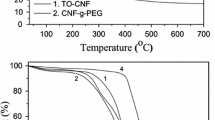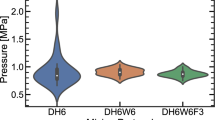Abstract
The lengths of ten types of cellulose nanofibrils were evaluated by shear viscosity measurement of their dilute dispersions. Aqueous dispersions of surface-carboxylated cellulose nanofibrils with a uniform width of ~3 nm were prepared from wood cellulose by 2,2,6,6-tetramethylpiperidine-1-oxyl-mediated oxidation and successive mechanical treatment. Cellulose nanofibril samples with different average lengths were prepared by controlling the conditions of the oxidation or mechanical treatment. The viscosity-average lengths, L visc, of the nanofibrils were calculated by applying the shear viscosities of the dilute dispersions to an equation for the dilute region flow behavior of rod-like polymer molecules. The obtained L visc values ranged from 1,100 to 2,500 nm and showed a linear relationship to the length-weighted average length, L w, measured by microscopic observation; the relation was described as L visc = 1.764 × L w + 764. The influences of the electric double-layer of the nanofibrils and surface-carboxylate content on the value of L visc were also investigated.







Similar content being viewed by others
References
Araki J (2013) Electrostatic or steric?–preparations and characterizations of well-dispersed systems containing rod-like nanowhiskers of crystalline polysaccharides. Soft Matter 9:4125–4141
Araki J, Wada M, Kuga S, Okano T (1998) Flow properties of microcrystalline cellulose suspension prepared by acid treatment of native cellulose. Colloids Surf A 142:75–82
Azizi Samir MAS, Alloin F, Dufresne A (2005) Review of recent research into cellulosic whiskers, their properties and their application in nanocomposite field. Biomacromolecules 6:612–626
Boluk Y, Lahiji R, Zhao L, McDermott MT (2011) Suspension viscosities and shape parameter of cellulose nanocrystals (CNC). Colloid Surf A 377:297–303
Brown RM Jr, Saxena IM, Kudlicka K (1996) Cellulose biosynthesis in higher plants. Trends Plant Sci 1:149–156
Carr ME Jr, Hermans J (1978) Size and density of fibrin fibers from turbidity. Macromolecules 11:46–50
Dimic-Misic K, Puisto A, Gane P, Nieminen K, Alava M, Paltakari J, Maloney T (2013) The role of MFC/NFC swelling in the rheological behavior and dewatering of high consistency furnishes. Cellulose 20:2847–2861
Doi M, Edwards SF (1986) The theory of polymer dynamics. Oxford University Press, New York
Eichhorn SJ (2011) Cellulose nanowhiskers: promising materials for advanced applications. Soft Matter 7:303–315
Eichhorn SJ, Dufresne A, Aranguren M, Marcovich N, Capadona J, Rowan S, Weder C, Thielemans W, Roman M, Renneckar S (2010) Review: current international research into cellulose nanofibres and nanocomposites. J Mater Sci 45:1–33
Elazzouzi-Hafraoui S, Nishiyama Y, Putaux JL, Heux L, Dubreuil F, Rochas C (2008) The shape and size distribution of crystalline nanoparticles prepared by acid hydrolysis of native cellulose. Biomacromolecules 9:57–65
Fukuzumi H, Saito T, Iwata T, Kumamoto Y, Isogai A (2009) Transparent and high gas barrier films of cellulose nanofibers prepared by TEMPO-mediated oxidation. Biomacromolecules 10:162–165
Gericke M, Schlufter K, Liebert T, Heinze T, Budtova T (2009) Rheological properties of cellulose/ionic liquid solutions: from dilute to concentrated states. Biomacromolecules 10:1188–1194
Haward SJ, Sharma V, Butts CP, McKinley GH, Rahatekar SS (2012) Shear and extensional rheology of cellulose/ionic liquid solutions. Biomacromolecules 13:1688–1699
Hori R, Wada M (2005) The thermal expansion of wood cellulose crystals. Cellulose 12:479–484
Ishii D, Saito T, Isogai A (2011) Viscoelastic evaluation of average length of cellulose nanofibers prepared by TEMPO-mediated oxidation. Biomacromolecules 12:548–550
Ishii D, Saito T, Isogai A (2012) Correction to viscoelastic evaluation of average length of cellulose nanofibers prepared by TEMPO-mediated oxidation. Biomacromolecules 13:1706
Israelachvili JN (2011) Intermolecular and surface forces, 3rd edn. Elsevier, London
Iwamoto S, Lee S-H, Endo T (2014) Relationship between aspect ratio and suspension viscosity of wood cellulose nanofibers. Polym J 46:73–76
Mason SG (1950) The motion of fibers in flowing liquids. Pulp Pap Mag Can 51:93–100
Okita Y, Saito T, Isogai A (2010) Entire surface oxidation of various cellulose microfibrils by TEMPO-mediated oxidation. Biomacromolecules 11:1696–1700
Parra-Vasquez ANG, Stepanek I, Davis VA, Moore VC, Haroz EH, Shaver J, Hauge RH, Smalley RE, Pasquali M (2007) Simple length determination of single-walled carbon nanotubes by viscosity measurements in dilute suspensions. Macromolecules 40:4043–4047
Saito T, Isogai A (2004) TEMPO-mediated oxidation of native cellulose. The effect of oxidation conditions on chemical and crystal structures of the water-insoluble fractions. Biomacromolecules 5:1983–1989
Saito T, Kuramae R, Wohlert J, Berglund LA, Isogai A (2013) An ultrastrong nanofibrillar biomaterial: the strength of single cellulose nanofibrils revealed via sonication-induced fragmentation. Biomacromolecules 14:248–253
Sakurada I, Nukushina Y, Ito T (1962) Experimental determination of the elastic modulus of crystalline regions in oriented polymers. J Polym Sci 57:651–660
Saxena IM, Brown RM Jr (2005) Cellulose biosynthesis: current views and evolving concepts. Ann Bot 96:9–21
Shinoda R, Saito T, Okita Y, Isogai A (2012) Relationship between length and degree of polymerization of TEMPO-oxidized cellulose nanofibrils. Biomacromolecules 13:842–849
Siró I, Plackett D (2010) Microfibrillated cellulose and new nanocomposite materials: a review. Cellulose 17:459–494
Tanaka R, Saito T, Isogai A (2012) Cellulose nanofibrils prepared from softwood cellulose by TEMPO/NaClO/NaClO2 systems in water at pH 4.8 or 6.8. Int J Biol Macromol 51:228–234
Acknowledgments
This research was supported by Grants-in-Aids for Scientific Research (grant numbers 21228007, 23688020, and 201307645) from the Japan Society for the Promotion of Science (JSPS). We would like to thank Dr. Takehiko Uematsu and Anton Paar Japan K. K. for their assistance in shear viscosity measurements.
Author information
Authors and Affiliations
Corresponding author
Electronic supplementary material
Below is the link to the electronic supplementary material.
Rights and permissions
About this article
Cite this article
Tanaka, R., Saito, T., Ishii, D. et al. Determination of nanocellulose fibril length by shear viscosity measurement. Cellulose 21, 1581–1589 (2014). https://doi.org/10.1007/s10570-014-0196-4
Received:
Accepted:
Published:
Issue Date:
DOI: https://doi.org/10.1007/s10570-014-0196-4




